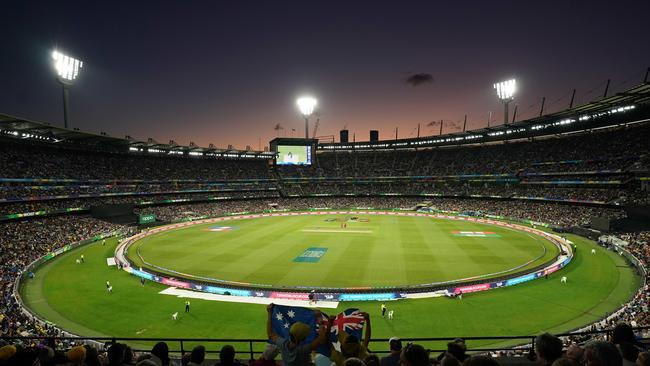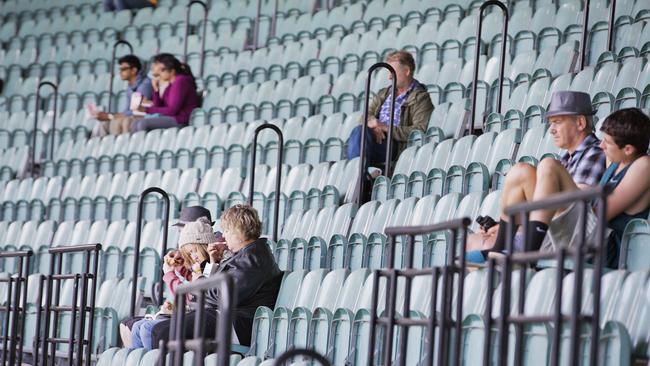Sparse MCG stands to reveal power of the people
Getting full-fledged crowds back to cricket, and sport more generally, is of significance way beyond its financial impact as we will discover at the MCG on Boxing Day.

This comes with a downside: even quite respectable crowds distribute uneasily, almost apologetically, around the G’s capacious tiers and terraces. A half-full MCG can just as readily seem half-empty, incapable even of sustaining a Mexican wave, with its standard egalitariat boo for the members. Imagine that aforementioned Cup final before 40,000, rather than more than 86,000: same game, somehow less epic.
Imagine, too, that final had it turned into a contagion event thanks to the patron who sat in section N42 on Level 2 of the Northern Stand without knowing they had contracted COVID, learning of this only three days later.
It’s this scenario that has haunted sports authorities ever since: it was within a week of the Women’s T20 World Cup Final that Scott Morrison recommended the cancellation of all non-essential gatherings involving more than 500 people, fearful of their super-spreading potential.
That could be our third imagining — what might have been had the cup final fallen just a little later. Contemplate Meg Lanning’s brilliant team gazing round a yawning stadium, Katy Perry’s voice bouncing off echoey stands. Instead of communal affirmation, a sense of anticlimax, lost opportunity, cheated destiny.
So to today, when about 30,000 souls will be scattered round the MCG for an event that might have attracted as many as 80,000. Does it matter? There is no pretending otherwise. Just as Donald Trump needed to lie endlessly about the biglyness of his inauguration crowd, sports needs the reinforcement of an attendant chorus.
For sports fans, it is the opportunity to lay down individual memories, rather than the same memory as everyone else via television, the investment of a little effort, inconvenience and discomfort with the uncertain promise of reward. For sports journalists, it is the chance to get a little closer to the watched and the watchers, to feel as well as to see, to compare as well as to consume.
Even broadcasters, who might be thought in favour of bums on couches rather than on seats, acknowledge the value of such experiences: crowds thinned out by COVID-19 considerations form part of Seven West Media’s argument that the summer is diminished.
This played a part in the football codes’ acquiescence in negotiation with their broadcast partners; it underlay the spooky sound effects of the Indian Premier League, where every cheer sounded identical, to the extent that the cricket itself began to feel inorganic, slightly robotic.
A crowd is something to live up to; it crowns a game; it confers success. The moment Kerry Packer knew that he had prevailed in his rivalry with cricket’s authorities was the night in November 1978 when a World Series Cricket white-ball fixture sent the turnstiles spinning nearly 50,000 times at the Sydney Cricket Ground. The moment the Big Bash League surged in significance was five years ago when a derby at the MCG drew more than 80,000.
Which is ironic, because as they have loomed larger in imagination, attendances have been diminishing in proportional contribution to sport’s exchequer.
This had the outcome, 15 years ago, of Cricket Australia assenting in Packer’s long-held ambition of broadcasting “live against the gate”. Until that time, if you recall, the convention had been that television coverage in the city of origin, in order not to discourage attendance, should be limited to a session.
Researching in the records of Cricket Australia a few years ago, I even found a board minute from 1983 nicely articulating this former convention: “The lifeblood of the game is the paying customers, not only because of the revenue they bring the game but because of the atmosphere they create at the ground for the cricketers and as a following to the television audience around Australia. This atmosphere has been an important element in the success of the game.”

As broadcasting revenue swelled as a proportion of the whole, it eclipsed the turnstile to the point that CA could put this thesis to the test. The sky did not fall; indeed, it has held up well. Despite the ready alternative of watching from home, attendances at Test matches in Australia have remained robust.
It may be that the contrary has become true — that attendances would come under pressure were cricket not on television. Packer’s thesis was always that broadcasting stimulated patronage; it contained the corollary, seldom remarked, that without that stimulus, cricket might dwindle in the national imagination. CA’s tie-up with Fox Sports will provide grist for the mills of analysis.
At the same time, television has found some truth in that board minute from before the Hawke prime ministership. The viewing audience still takes its cues from the live audience. The crowd reaction; the successful player acknowledging acclaim; the failed player trailed by disappointment: in addition to being integral to the theatre of the live experience, these remain essential elements of television’s grammar.
Getting full-fledged crowds back to cricket, and sport more generally, is of significance way beyond its financial impact. It will also be a sporting contribution to the post-COVID settlement.
There will be those who, for all sorts of reasons, will resist vaccination. Sport should have no truck with them. Vaccination is not something merely done, or not done, for oneself. It is a gesture towards our fellow citizens. Cricket and other sports should be laying down policies to restrict access to events to those who have suitable health clearance. No jab, no watch.
A year hence, inshallah, the Melbourne Cricket Ground will host an Ashes Test. Given the pent-up demand, one would not be surprised to see it filling the MCG as it has not been filled since the aforementioned Women’s T20 World Cup final, and threatening the attendance record of 271,865 set by the Ashes Test of 2013. Anti-vaxxers will be perfectly free to watch — on television.







Few sports experiences are quite so compelling as a Melbourne Cricket Ground testing its six-figure capacity. Witness this year’s final of the Women’s T20 World Cup — an unforgettable celebration of the event, the format, the nation and the giant strides of female sport, all on International Women’s Day.